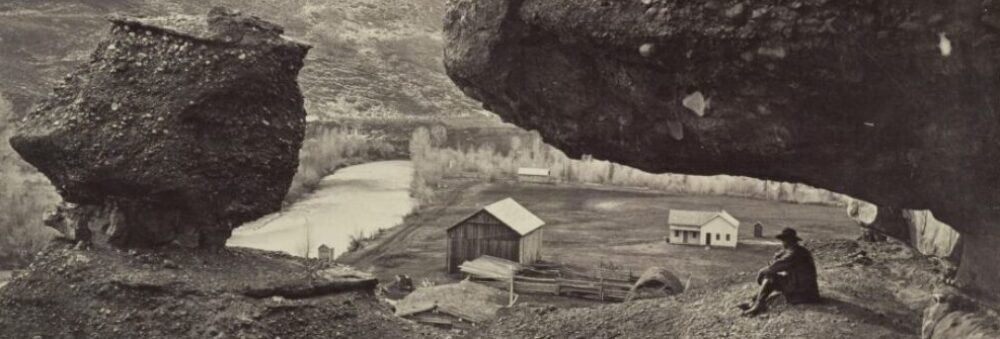![Catlin, George. Buffel-jagter. [colophon: Stockholm: tryckt hos P.G. Berg, 1855].](https://i0.wp.com/americana.princeton.edu/wp-content/uploads/sites/43/2014/03/Swedish-1.jpg?resize=237%2C300&ssl=1)
Catlin, George. Buffel-jagter. [colophon: Stockholm: tryckt hos P.G. Berg, 1855]. Call Number: In Process.

![Catlin, George. Buffel-jagter. [colophon: Stockholm: tryckt hos P.G. Berg, 1855].](https://i0.wp.com/americana.princeton.edu/wp-content/uploads/sites/43/2014/03/Swedish-1.jpg?resize=237%2C300&ssl=1)
Catlin, George. Buffel-jagter. [colophon: Stockholm: tryckt hos P.G. Berg, 1855]. Call Number: In Process.
The Western Americana Collection recently acquired an album of ninety-one photographs of scenes in Northern and Central Mexico in the 1880s. The images present city views, street scenes, cathedrals, and various merchants and workers. Sixty-one of the photographs are attributed to William Henry Jackson (1842-1943), while nine are attributed to French photographer Abel Briquet. Notable among the remaining unattributed photographs are nine candid street scenes in Villa Lerdo, Durango.
William Henry Jackson, known for his iconic Indian portraits and landscape photographs of the American West, traveled to Mexico in 1883 under commission of the Mexican Central Railroad Company to document the inaugural passage between Ciudad Juárez and Mexico City (Debroise, 76). While documenting the Mexican railroad, which connected with the Santa Fe Railroad, Jackson also directed his lens toward the surrounding landscape, city views, buildings, and local inhabitants. In the same year, French photographer Abel Briquet was commissioned by Compagnie Maritime Transatlantique to document the ports of Mexico (Debroise, 79). Like Jackson, Briquet also turned his gaze to the inhabitants and surrounding cities. While Jackson only stayed briefly in Mexico (returning in 1884 to finish documenting the railroad), Briquet stayed on and opened a photography studio in Mexico City in 1885, making him the first commercial photographer in Mexico.
The newly acquired Mexico album has been fully digitized (available here) and supplements the department’s two significant portfolios containing William Henry Jackson photographs of the American West: Photographs of North American Indians (WC054) and the Sheldon Jackson Collection of Indian Photographs (WC055). These additional portfolios have been digitized in full and are accessible via the Princeton University Digital Library. See: Photographs of American Indians and Sheldon Jackson Collection of Indian Photographs.
Bibliography:
Debroise, Olivier. Mexican Suite: A History of Photography in Mexico. Translated and revised in collaboration with the author by Stella de Sá Rego. Austin, TX: University of Texas Press, 2001.
Frontiersman and stage entertainer William F. Cody launched his Buffalo Bill Wild West show on the plains of Omaha, Nebraska, in 1883. Though the touring show had a slow and unprofitable start, by 1886 it had found its financial footing. In 1887, to coincide with Queen Victoria’s Golden Jubilee, the entire troupe (cowboys, Indians, horses, buffalo, wagons and all) sailed abroad to England. The London performances were an immediate success, even the Queen attended, prompting a second European tour through France, Spain, Italy, and Germany beginning in 1889.

Buffalo Bill: Il Domatore delle pelli rossi. Terribili avventure fra I Selvaggi Indiana. Rome, Edoardo Perino, 1890.
The Western Americana collection recently acquired a complete 40 issue set of illustrated adventure tales that were likely published to coincide with the company’s travels through Italy: Buffalo Bill: Il Domatore delle pelli rossi. (Buffalo Bill: Tamer of the Redskins). The issues were published by Edoardo Perino in Rome in 1890, the year the troupe performed in Rome and the year Cody had an audience with Pope Leo XII at the Vatican. The Italian tales and illustrations display the same melodramatic style found in the American Buffalo Bill dime novels and stage plays that helped spread Cody’s fame in the 1870s. Interestingly, several of the illustrations in the Italian Buffalo Bill are attributed to French artist Paul Philippoteaux, best known for large cyclorama paintings depicting historical battles, such as the Battle of Gettysburg.
As seen in the images below, issues of Buffalo Bill: Il Domatore delle pelli rossi were sold for 5 centimes, while the entire collection could be purchased for 2.50 lire. The set is now quite scarce: a copy is recorded in the Biblioteca Universitaria Alessandrina in Rome and the Princeton copy is likely the only set in the United States.
2021 Update: Princeton copy now fully digitized and available online–Buffalo Bill: Il Domatore delle pelli rossi .
Bibliography:
Blackstone, Sarah. Buckskins, Bullets, and Business: A History of Buffalo Bill’s Wild West. Westport, CT: Greenwood Pres, 1986.
Ewig, Rick. “Cody, William Frederick.” American National Biography Online. http://www.anb.org/articles/18/18-01807.html (accessed January 4, 2014).
Kasson, Joy S. Buffalo Bill’s Wild West: Celebrity, Memory, and Popular History. New York: Hill and Wang, 2000.
Russell, Don. The Lives and Legends of Buffalo Bill. Norman, OK: University of Oklahoma Press, 1960.
Thanks to the generous gift of Larry S. Pierce, the library recently acquired an 8×10 field camera manufactured by the Rochester Optical Co., ca. 1905. The camera, labeled as the “Improved Empire State,” includes the camera body, lens board & lens, extension rail, a cable release, and three plate holders. Two of the plate holders are stamped “Drake Brothers Studio, Silverton, Oregon” on the inside cardboard septum (the septum being a sheet that separates one side of the plate holder from the reverse side, thus allowing each plate holder to house two undeveloped negatives). Photographers June Drake and his brother Emory Drake founded Drake Brothers Studio in 1900, and the brothers operated together until a fire destroyed their studio in 1908. June Drake continued, however, to photograph in a new studio until his retirement in 1960.
In 2012, the Manuscripts Division acquired an archive containing nearly nine hundred photographs taken by the Drake brothers. Along with the studio stamp on the back, many of the photographs contain detailed manuscript notes by June Drake. The notes include dates, identification of individuals, and the names of buildings and streets (many of which no longer exist in Silverton). For more information about the archive, see: Drake Bros. Studio Photograph Collection.